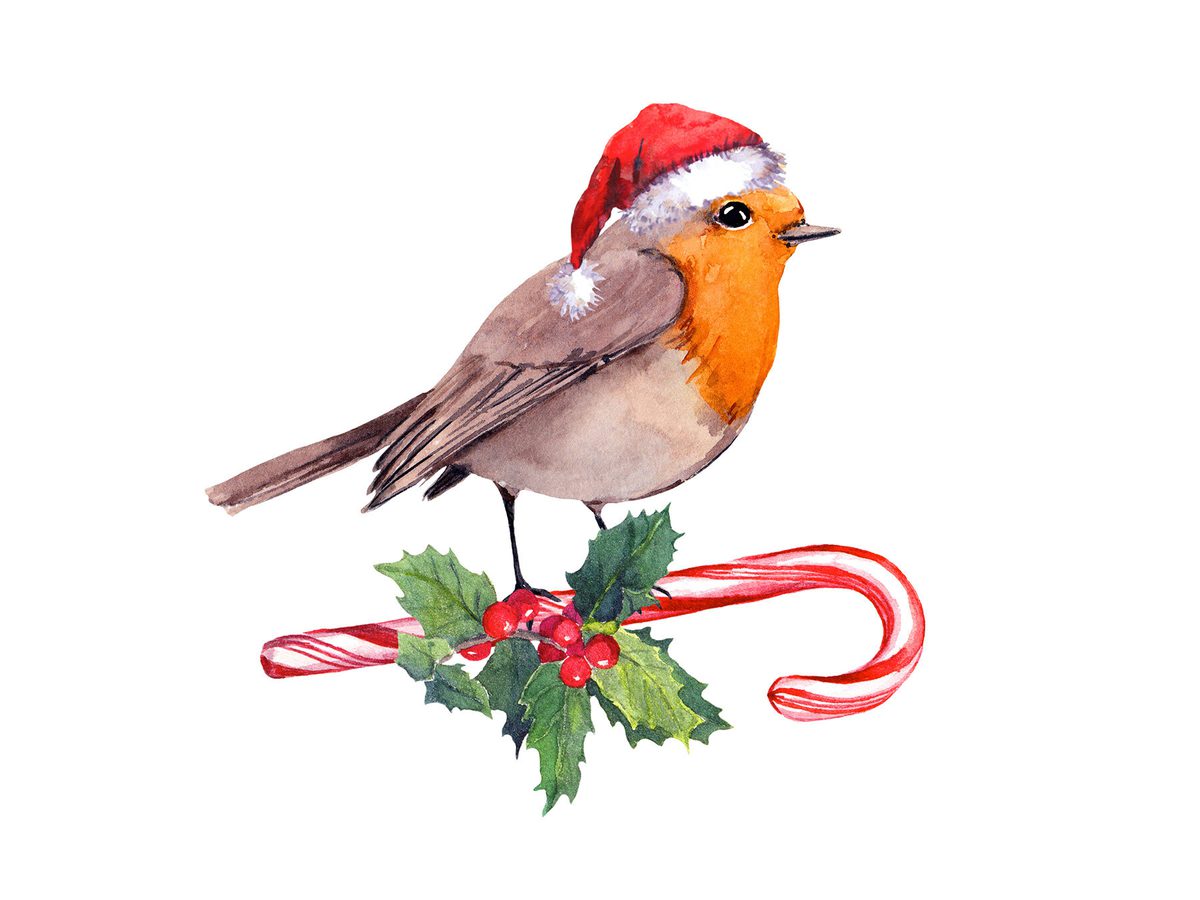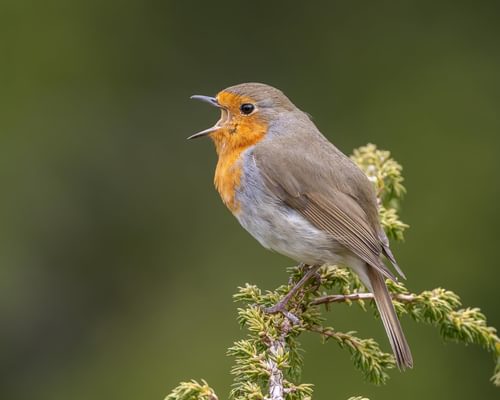The cheerful image of a red-breasted robin perched in the middle of a snowy winter scene is a popular theme on many a Christmas card. Robins may well be the first bird that comes to mind when we think of winter wildlife.
But why are robins linked with Christmas? And when did these iconic garden birds first become a traditional festive symbol? If you’ve ever wanted to know more about the Christmassy heritage of robins, you’re in the right place!
The robin’s strong associations with the Christmas period can be traced back to long before the species was named Britain’s national bird in 1960. In Victorian times, postal workers delivering festive mail were nicknamed ‘robins’ as their red jackets resembled the red-breasted birds.
Some believe that the tradition of robins being associated with Christmas time goes back further still, with fables citing the presence of a robin around the time of Christ’s birth. According to the legend, a tiny brown bird hopped too close to the fire that was burning in the stable where Mary had given birth, and got scorched by an ember, gaining the red breast feathers that were passed onto future generations of robins.
Other long-established links between robins and wintery weather come in the form of nursery rhymes and fairy tales, and ancient legends from Celtic tradition.
We’ll be taking a look at these cultural references relating to this popular garden visitor below, so read on if you’re interested in finding out more.

There are many different links with Robins being associated with Christmas in the UK
What is the significance of Robins at Christmas?
Since Victorian times, robins have appeared on Christmas cards, decorations, tableware and even in recent times, featured on the design of Christmas jumpers. It’s unclear exactly why this cheerful red-breasted songbird has become so synonymous with the festive period, but there’s no denying that above any other bird species, robins have the strongest claim to the “Most Christmassy Bird” crown.
One popular belief ties in robins to postal workers, who since Victorian times, have been delivering our letters and parcels throughout the year, dressed in their iconic red jackets ‒ and these cheerful messengers bringing good news to homes were soon likened to familiar red-breasted robins.
Sending Christmas cards became a popular annual tradition from the 1880s onwards, and these soon became accompanied by newsy correspondence, known as ‘round robins’, which gave updates of all that had been happening in the sender’s life that year.
Robins have quite a distinctive appearance, and a reputation as friendly, cheerful garden companions, so quickly became the ideal species to use as an uplifting nature-inspired Christmas symbol.

Robins are are everywhere at Christmas, including cards, decorations and even jumpers!
The history and origins of Robins at Christmas
The symbolism of robins with the Christmas period may have originated even further back than the Victorian era, with some tales of a red-breasted bird being present at the time of the birth of Christ.
According to legends from early Christianity, a fire had been lit in the stable to keep the newborn baby Jesus warm. A small brown bird appeared and placed itself between the flames and the manger where the baby was sleeping, and in the process, scorched its breast feathers which became flame-red as a result.
Interpretations include the robin’s thoughtful actions protected Christ from being burned, and the red-colouring was then passed down to future generations of robins, as a visual reminder of the bird’s kind actions. Of course, no documentary evidence exists to verify this tale, but it illustrates that robins have long been recognised as a positive cultural symbol, particularly during the Christmas period.

Close up of a Robin stood in the snow
Towards the end of the 19th century, robins began their rise to prominence as the iconic Christmas bird we know them as today. The advent of the postal service in the Victorian era, followed by the introduction of commercially produced Christmas cards delivered by red-jacketed postal workers and the development of the trend of so-called ‘round robin’ Christmas newsletters exchanged between relatives all contributed to the popularity of the robin redbreast as a festive symbol.
Robins began to feature in illustrations used on Christmas greetings cards from the 1880s onwards, and quickly became one of the most popularly used themes. Their bright and instantly recognisable appearance stood out well against winter snow scenes, and with the rapid commercialisation of Christmas-related manufacturing as the 20th century progressed, they became firmly cemented as a key symbol of the festive season.
Robins were named the official bird of Britain in 1960, and can now be found on wrapping paper, candles and candle-holders, baubles, garlands, decorations, and tableware, as well as festooning the fronts of Christmas jumpers, bobble hats, scarves and Christmassy baby clothes.

Robin on the search for food in the winter
When did Robins first appear on Christmas cards?
Festive greetings cards, with designs featuring bright-eyed, red-breasted robins against snowy backgrounds, dotted with holly leaves and shiny berries are a common sight on mantelpieces all around the country at Christmastime.
The first commercially produced Christmas cards were sent in 1843, featuring family scenes, religious themes, Christmas trees, candles and holly wreaths. It wasn’t until the 1880s that robins first started to appear.
With the introduction of the postal service, and the important role of postal workers in delivering Christmas cards and letters, many early cards featured drawings of jolly, red-jacketed postmen against a festive backdrop.
These soon became replaced by illustrations of their namesake ‘redbreast’ birds, drawn with Christmas cards in their beaks as an amusing take on the delivery ‘Robins’ who worked for Royal Mail. And from then on, the Christmas-card robin has never looked back!

A festive Christmas card design featuring a Robin
Do Robins only come out at Christmas?
Robins are resident in the UK all year round, and are certainly not “just for Christmas”. They can be seen hopping around in gardens and on bird tables in all seasons, not just when snow is on the ground, as Christmas cards may have you believe! Their cheerful song can be heard throughout the year, particularly in the spring.
Most robins that live in England do not migrate, although a small minority do spend winter in warmer parts of Europe, including southern France and Spain. The UK’s robin population increases in the colder months as birds from northern Russia and Scandinavia arrive to spend the winter there.

It's a common misconception that Robins are only seen during the winter, around Christmas
Other associations with Robins
Robins’ association with colder months is not limited to Christmas. One 16th-century childhood nursery rhyme, “The North Wind Doth Blow”, questions the bird’s ability to cope with snowy weather, with the line “The North wind doth blow and we shall have snow, And what will the robin do then, poor thing?”.
Cold weather and robins are also a theme in the Babes in the Wood fairy tale, where the bodies of the young children who have fallen victim to the extreme cold are covered with leaves by the kindly robins.
Celtic traditions include the story of a feud between the Winter Holly King (a wren) and the Summer Oak King (a robin), with each bird driving the other away for part of the year, giving rise to the different seasons. This can be interpreted as another association between robins having a deep-rooted connection to winter months, and by default, Christmas.
Robins are believed to have spiritual symbolism too, with many people believing that a visit from a robin indicates the presence of a loved one who has passed away, and is a sign that they are at peace. Other beliefs include that a robin may be considered an omen of impending death or illness, and a robin tapping on your window may be a sign of imminent bad fortune.

Robin perched on a frost branch with red berries
Are American Robins associated with Christmas?
American robins are different in appearance to the ones we see in gardens, parks and allotments in the UK. With a darker, charcoal-coloured back and wing plumage and an orange breast, robins native to the United States do not invoke the same festive associations as our red-breasted garden songbirds.

American Robin

